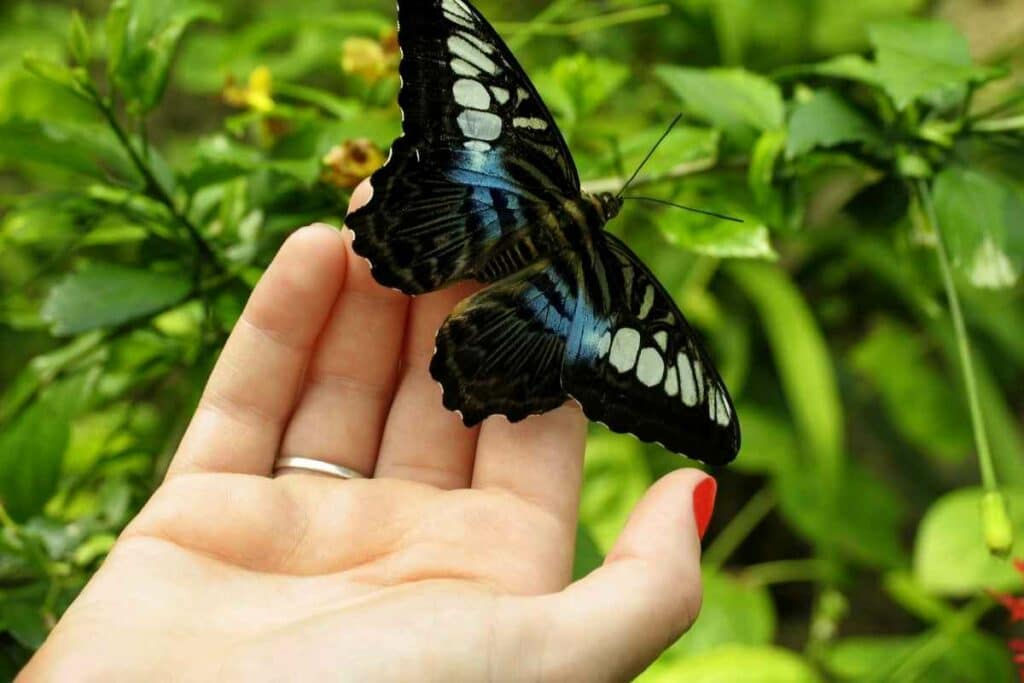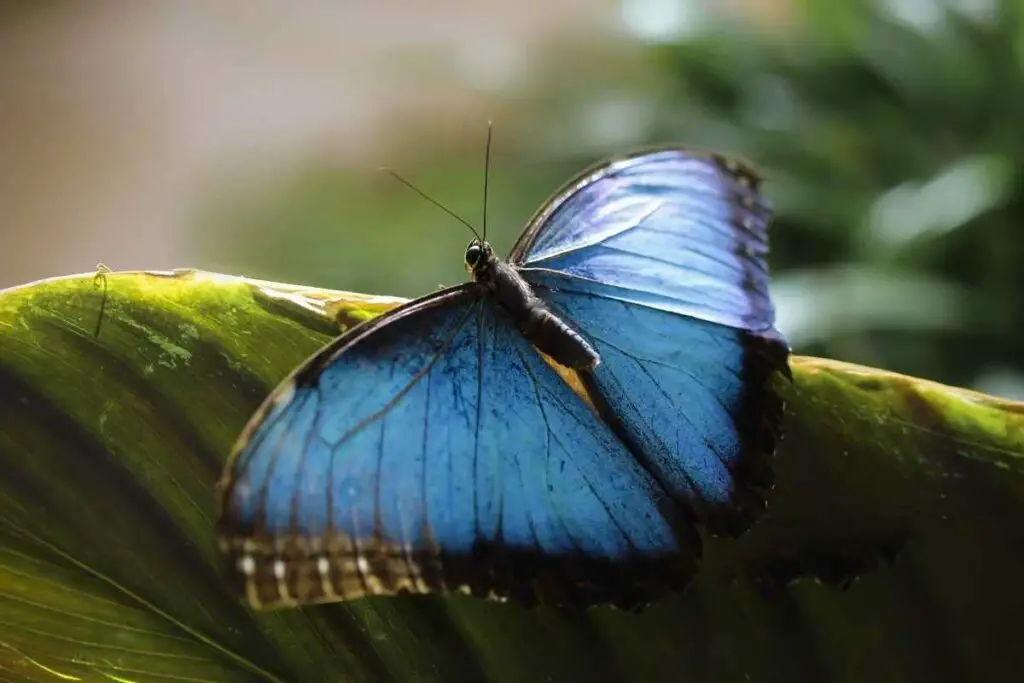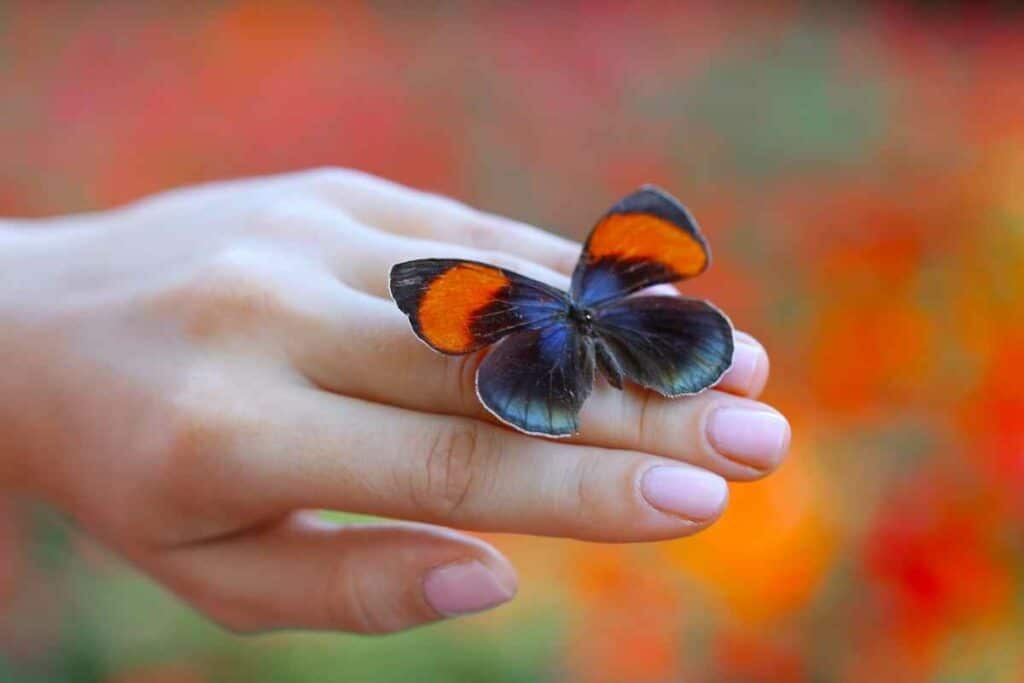It sounds disgusting, but because butterflies only feed on liquids, it is entirely possible that these insects might drink exposed or puddled blood, especially as it is mineral-rich, though this is not a primary source of nutrition for most butterfly species.
Butterflies derive their nourishment from a surprisingly diverse range of sources including foul and rotting matter.
If you want to learn more about the remarkably unrefined diet of a buttery, this article will explore butterfly feeding and diet as well as introduce a member of the butterfly (Lepidoptera) family that does actively suck blood!
Blood, Sweat and Tears Are Just Some of the Foods on the Menu of a Butterfly
It is important to stress that most butterflies will primarily feed on flower nectar using the adapted feeding tube we discuss below.

However, they are not limited to nectar and will actually taste anything and everything that provide them with the essential nutrients and minerals they need including:
- Carrion
- Urine
- Tree sap
- Rotting fruit
- Dung
- Dissolved soil
- Wet sand
- Sweat
- Decaying flesh
- Carcasses
- Animal tears
- Blood
Pretty much anything goes if it is moisture rich, or contains sugars for energy or the salts and minerals needed for reproduction.
Butterflies have even been known to land on people and feed on their sweat to get the salts they crave!
There Is Even a Lepidoptera Species That Specifically Feeds on Animal and Human Blood!
This horrific creature is known as the Vampire Moth (Calyptra thalictri) hails from Siberia where it was discovered as recently as 2008 and has since spread throughout northern Europe.
This bloodthirsty moth was such a voracious bloodsucker that it has no hesitancy in drilling its tongue into the human hand offered by an investigator.
It has adapted to drink blood in preference to other food sources with a barbed tongue capable of penetrating flesh.
Like a giant mosquito, it craves the nutrional hit it can get from blood which far exceeds more benign sources like fruits.
Nutrient Source: The blood is then used to provide a nutritious nuptial gift to females during reproduction that can nourish the next generation of these winged fiends.
It Might Gross You out but Mud-puddling Is the Way That Butterflies Get the Nutrients They Need
Mud-puddling, also known as puddling is a distinctive behaviour seen in butterflies that involves them seeking moist and rotting substances (like mud) where they can suck up the protein and mineral rich liquid.

In certain regions, after heavy rains or as fruits have ripened and dropped, butterflies will congregate in significant numbers to avail themselves of the nutrient laden liquids that are available.
Dung and corpses can also be the location of mud puddling.
Male butterflies lead the way in displaying this behaviour to build up reserves of valuable nutrients for reproducts, that may even be gifted to the females they mate with.
After All the Havoc That Munching Caterpillars Cause, Adult Butterflies Don’t Eat!
Mature butterflies have a long tubular mouthpart called a proboscis through which they suck liquids up like a straw.
The tubular nature of their curled tongue means that they are limited to consuming liquids only, sipping water from droplets or sweet nectar from within flowers.
Anatomy of the Butterfly Mouth and Digestive System
The head of a butterfly is specially adapted for its liquid diet.
Two anatomical structures, in particular, facilitate butterfly feeding.
The Labial Palpi
The labial palpi are sensory projections on the front of the butterfly’s head that are covered in olfactory (smell) sensors.
They assist the butterfly in sensing moisture conditions in their environment and finding sources of food. They may also play a role in shielding the butterfly’s tongue, known as the proboscis.
Palpi may also be used as filters to protect the butterfly eyes as they feed on some of their more foul foodstuffs explored further on.
Defense: Some of the sites where butterflies feet are infested with mites so a well-developed pair of palpi can provide added protection!
The Proboscis
The Proboscis is a mouth structure that consisted of two grooved channels that link together to form a tube that is like a drinking straw.
The butterfly is reliant on this apparatus for feeding. The proboscis can be curled up and stored, then extended when the butterfly wants to feed.

If the butterfly feeds on a sticky substance that clogs the proboscis it can be dismantled and cleansed.
The proximity of the palpi to the probosis and taste sensors in the butterflys food canal, and on their legs, provide the butterfly with a “tasting” experience.
A Highly Adapted Digestive System Efficiently Processes the Ingested Liquids
The butterfly’s digestive tract is made up of a foregut, midgut and hindgut.
The forgut is designed to provide the sucking pressure that the butterfly needs to suck liquids through the proboscis.
These liquids pass down the butterflys pharynx (throat) and oesophagus to a crop.
The straight midgut which carries the digestive enzymes on its surface leads to a longer hindgut where much of the absorption of nutrients takes place.
Do Butterflies Eat Leaves?
Adult butterflies do not eat leaves, but their larvae (caterpillars) will ingest leaves to derive a store of potassium ions that will make the digestive tract of the mature butterfly acidic.
Butterflies and Decomposition
Butterflies make a massive contribution to the decomposition of biomass.

They often will visit the location of exposed cadavers repeatedly at varying stages of the decomposition process.
They have been found to be marked necrophages, reducing the mass of carrion significant through gradual liquefied consumption.
Rounding Up
Who would have thought that the diet of a butterfly could be so gruesome?
If this article has changed the way you view beautiful delicate butterflies forever, you are probably not alone.
However, butterflies make an irreplaceable contribution to biodiversity and a healthy ecosystem and though their caterpillars can be pests, butterflies are important pollinators that every productive garden needs.
So next time you see one flutter by, admire it, but perhaps don’t get too close as you don’t know where it’s been!


